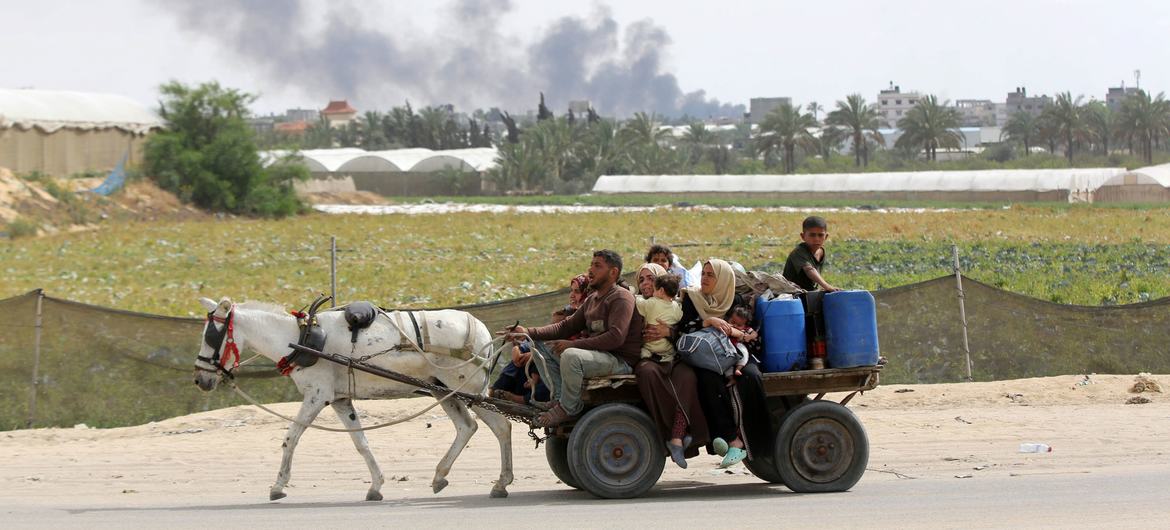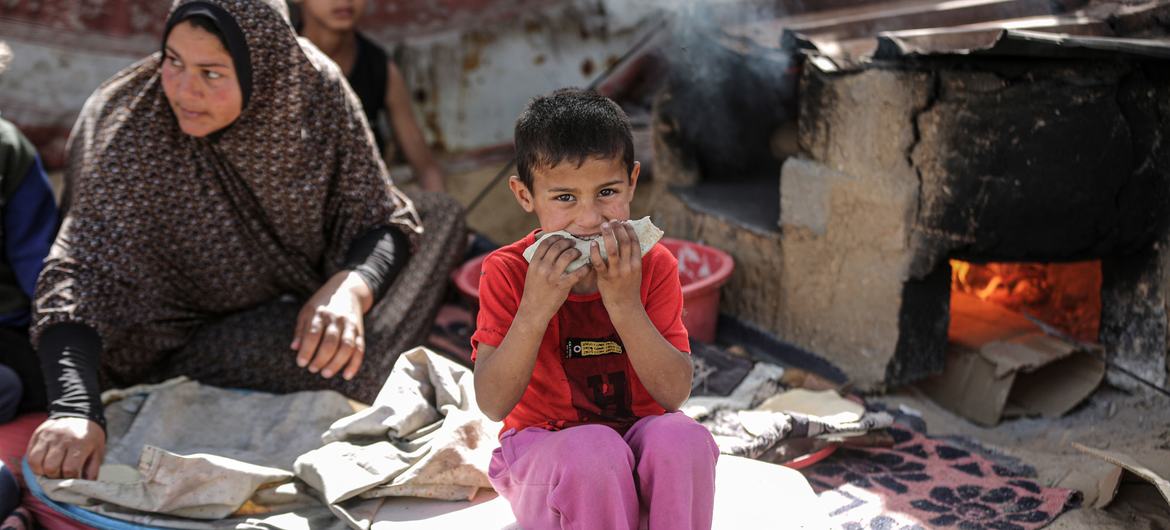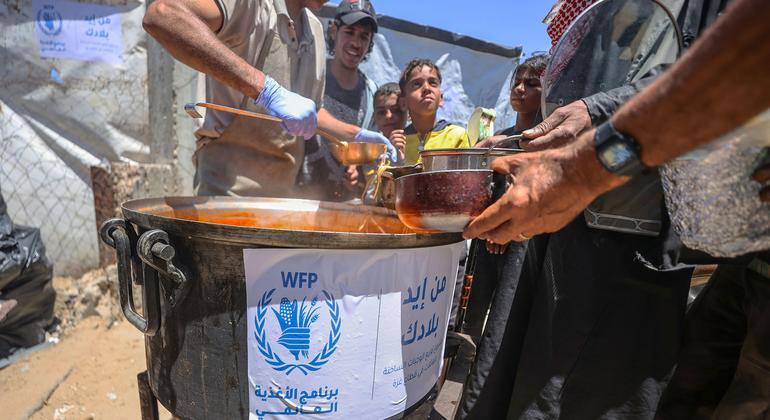Andrea De Domenico, Head of OCHA‘s Office in the occupied Palestinian territory, recently spent three weeks in the enclave, where over one million people have fled the southern city of Rafah following the step-up in Israeli military operations, according to Palestine refugee agency UNRWA.
Briefing journalists in New York, Mr. De Domenico added that the operational environment for humanitarians also remains dangerous and challenging, despite engagement with the parties.
Hands tied
“At times I wonder if the humanitarian operation in Gaza (is) crippled by design. We are trying to save lives every day, but the reality is that our hands have been tied (behind) our backs since the very beginning,” he said, speaking from Jerusalem.
“We used to say, months back, that someone had broken our legs and now all of sudden asked us to run. I think we have learned to run with crutches, if you want, and now they have taken away the crutches also”.
Aid convoy sacked
He also pointed to the difficult of not just bringing aid into Gaza but then delivering it to people in need, such as women, children, the elderly, and people with disabilities, all amid security, safety and logistic challenges.
“Unfortunately, once again, we are living through the breakdown of law and order,” he said.
“Two days ago, we had the worst of our experiences in bringing in commodities, where almost 70 per cent of the convoy that we were able to put together for that day did not reach the final destination because it was intercepted by mostly criminals but also desperate people”.

More families flee Rafah after intensification of military operations.
‘A wave of people’
Mr. De Domenico shared what he said are five images that remain in his mind following this latest visit to Gaza, including “the forcible transfer of people” who thought they had found refuge in Rafah but are now seeking safety elsewhere. An estimated 20,000 pregnant women are among them.
“It’s impossible as of today to move from Al Mawasi, where some of our premises are, to go to Khan Younis or Deir al Balah without literally navigating through a wave of people that are everywhere,” he said, speaking from Jerusalem.
The journey, which would normally take up to 15 minutes, now takes an hour, as more and more people head north “with whatever they can gather, putting it in donkey carts and piling them up at unbelievable heights”.
He also recalled driving along the coastal road one day and seeing scores of Gazans on the seashore. He learned they were there to cool off, given the hot daytime temperatures inside the tents where they are now living.
“By doing this, also they took the opportunity to wash themselves because there is no other way that people can maintain some decent hygiene,” he said.
Social fabric eroding
“This intensity of living conditions is progressively eroding the social fabric of the community in Gaza,” he continued.
Recalling the “formidable” hospitality of the people, he said that even the poorest families would find a way to “put something on the table” for visitors. Additionally, social bonding among immediate and extended family members is fundamental in Palestinian society.
“What we are witnessing more and more is that this fabric is progressively being destroyed, where the rule of the strongest is becoming the only rule that is prevailing simply because there is so little for people to survive that only the strongest can have access to that.”
He was told about a dispute between two brothers over a can of chickpeas. The two families are no longer speaking “and losing that network of mutual solidarity and support that is essential in a situation of despair like this”.
Living conditions are further compounded by the lack of basic commodities and access to simple tools, materials, and equipment, even just for cooking meals.
A “very, very acrid and strong” odour permeates the air around dinner time as families burn plastic, garbage or whatever else they can find to use as fuel in the place of cooking gas, he said.
Violence and constant trauma
Mr. De Domenico also spoke about the aftermath of the deadly Israeli airstrike on 26 May that hit a camp for displaced people in Rafah, sparking a fire that killed many people. Ambulances transported the dead and wounded to field hospitals concentrated along the Al Mawasi area.
He said a director of one of the field hospitals told him that among the charred bodies were those of a man who was still hugging his young daughter. The medical staff tried to separate them but were unable to do so. The only option would have been to break their bones, which he said they refused to do, leaving them together “in this final and eternal hug”.
Reflecting on the overall violence in Gaza, Mr. De Domenico wondered how children there will recover from “this unimaginable and difficult to describe situation of constant trauma that they have to go through”.
‘Gigantic’ health efforts
Nearly 36,000 people have been killed to date in Gaza, and almost 80,000 wounded, he said, citing figures from the Gaza health authorities.
Addressing the embattled health system, he noted that “the fact that we have to count on field hospitals….it means that these people can only be treated in sub-optimal conditions, despite the never-ending efforts of the medical teams that have been deployed all over the world are doing”.
The World Health Organization (WHO) has taken “gigantic efforts” to re-establish or maintain services in the Middle Area and in Khan Younis, he added, while there are no more functional hospitals in Rafah.
Humanitarians have faced “gigantic challenges” to bring tents, tarpaulins and other shelter equipment into Gaza. They also estimate that 36 sites operated by the UN Palestine refugee agency, UNRWA, that hosted displaced people have been lost.
Meanwhile, the amount of solid waste that has accumulated along the streets is “impressive”. He explained that landfills are generally located in margins along the fence towards Israel or Egypt “and those areas are absolutely not accessible”, so alternative locations are being sought.

Families in Gaza are struggling to find enough food to eat.
Concern for children
Mr. De Domenico said some 600,000 children have not attended school since the start of hostilities on 7 October, and there are no recreational activities for them, other than what local non-governmental organizations (NGOs) have managed to improvise.
“The reality is that there is very little that we can offer, and hence just the exposure to this violence and these very harsh living conditions that I’m sure will mark this generation of children for the long term,” he said.
Praise for humanitarians
The senior official praised local and international NGOs for their commendable efforts in the face of the many obstacles and dangers in Gaza.
Humanitarian teams are rotated in and out of the enclave through the Kerem Shalom crossing in UNRWA vehicles, and only using international drivers. A recent attempt by a convoy of seven vehicles was aborted at the last moment following 13 hours of waiting to get the go-ahead.
“Even to reach that place, we have to go through what is considered to be a safe road, notwithstanding that we have been caught in crossfire repeatedly,” he said.



